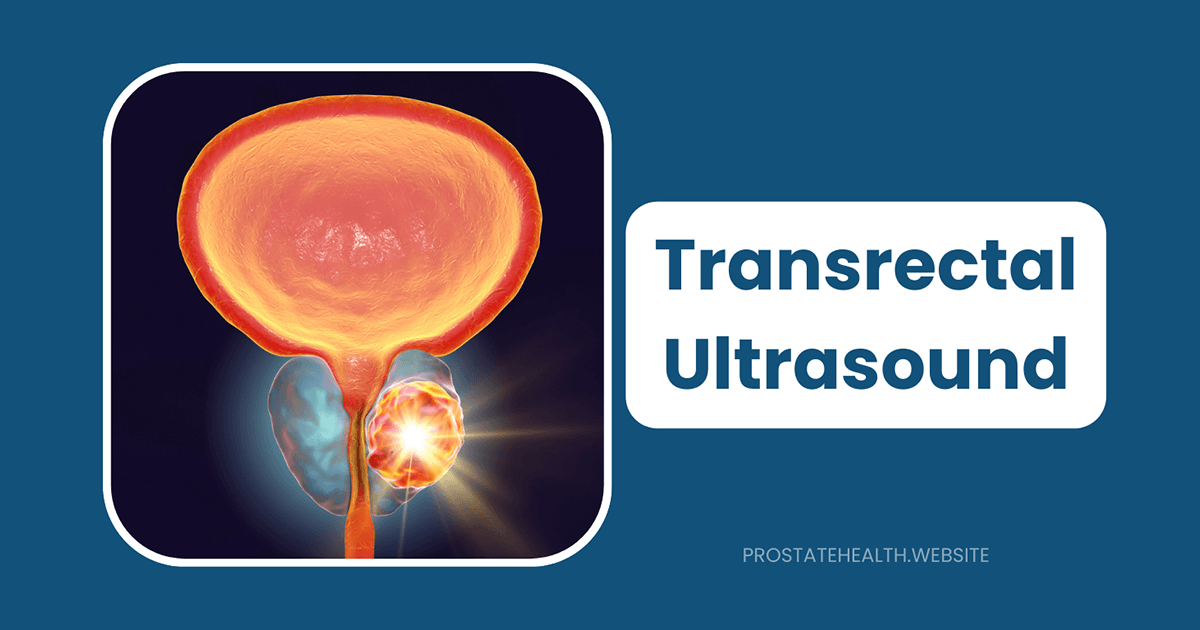Transrectal Ultrasound: What to Expect During the Procedure

When my doctor first mentioned that I needed a transrectal ultrasound (TRUS), I had many questions and concerns. Like many men, I found the prospect of this procedure somewhat uncomfortable to think about. However, understanding what to expect helped ease my anxiety significantly.
A transrectal ultrasound is a common diagnostic procedure that provides valuable information about the prostate gland. Whether you’re scheduled for a TRUS as part of a prostate cancer screening, to investigate urinary symptoms, or to guide a prostate biopsy, knowing what to expect can help you feel more prepared and less anxious.
In this comprehensive guide, I’ll walk you through the entire process—from preparation to recovery—based on the latest medical practices in 2025 and my own experience with the procedure.
What Is a Transrectal Ultrasound?
Before diving into the procedure itself, let’s understand what a transrectal ultrasound actually is:
The Basics
A transrectal ultrasound (TRUS) is an imaging technique that uses sound waves to create pictures of the prostate gland and surrounding tissues. The procedure involves inserting a specialized ultrasound probe into the rectum to obtain clear images of the prostate, which sits just in front of the rectum.
Common Reasons for a TRUS
There are several reasons why your doctor might recommend this procedure:
- Investigating abnormal PSA levels: If your prostate-specific antigen (PSA) blood test shows elevated levels
- Examining prostate abnormalities: To investigate findings from a digital rectal exam (DRE)
- Guiding prostate biopsies: To help precisely target areas of the prostate for tissue sampling
- Evaluating prostate size: To measure an enlarged prostate that may be causing urinary symptoms
- Monitoring existing conditions: To follow up on previously identified prostate issues
Dr. James Eastham, Chief of Urology at Memorial Sloan Kettering Cancer Center, explains: “Transrectal ultrasound gives us a window into the prostate that we can’t get through other non-invasive means. It’s particularly valuable when combined with a biopsy to diagnose or rule out prostate cancer.”
Preparing for Your Transrectal Ultrasound
Proper preparation can help ensure the procedure goes smoothly and produces the clearest possible images:
1-2 Weeks Before
- Medication review: Inform your doctor about all medications you take, particularly blood thinners like aspirin, warfarin, or clopidogrel. You may need to temporarily stop these medications 7-10 days before the procedure, especially if a biopsy will be performed.
- Antibiotic prescription: If you’re having a biopsy along with your TRUS, your doctor will likely prescribe antibiotics to take before and after the procedure to reduce infection risk.
The Day Before
- Diet considerations: You’ll typically be able to eat and drink normally before the procedure, but follow any specific instructions from your healthcare provider.
- Bowel preparation: You may be instructed to use an enema 1-4 hours before the procedure to clear your rectum. Some facilities provide the enema, while others may ask you to purchase one over the counter.
The Day of the Procedure
- Timing: Arrive at your appointment with plenty of time to check in and complete any paperwork.
- Empty your bladder: You’ll likely be asked to urinate just before the procedure.
- Clothing: Wear loose, comfortable clothing that’s easy to remove and put back on.
Dr. Stacy Loeb, a urologic oncologist at NYU Langone Health, advises: “Following preparation instructions carefully is important for getting clear images and, if you’re having a biopsy, for reducing the risk of complications. Don’t hesitate to call your doctor’s office if you have questions about how to prepare.”
The Procedure: Step by Step
Understanding exactly what happens during a transrectal ultrasound can help reduce anxiety about the unknown:
Setting and Duration
- Location: The procedure is typically performed in a urologist’s office, outpatient clinic, or hospital radiology department.
- Duration: A standard TRUS usually takes about 15-30 minutes. If a biopsy is included, it may take longer, typically 20-45 minutes total.
- Team: A urologist, radiologist, or specially trained technician will perform the procedure.
Getting Positioned
- You’ll be asked to remove clothing from the waist down and may be given a gown to wear.
- You’ll lie on your left side with your knees bent toward your chest (the left lateral position).
- Some facilities may use a different position, such as lying on your back with your feet in stirrups.
The Ultrasound Examination
- Probe insertion: The healthcare provider will cover the ultrasound probe with a condom-like sheath, apply lubricating gel, and gently insert it into your rectum. The probe is approximately the width of a finger.
- Image acquisition: The probe will be moved slightly to capture images of different parts of the prostate and surrounding tissues.
- Measurements: The size and volume of your prostate will be measured.
- Examination of suspicious areas: If abnormalities are seen, they will be examined more closely.
If a Biopsy Is Performed
If your TRUS is being done to guide a prostate biopsy, additional steps will include:
- Anesthesia: A local anesthetic will be injected to numb the area and reduce discomfort.
- Sample collection: A thin needle will be inserted through the probe to collect small tissue samples from the prostate.
- Multiple samples: Typically, 10-12 samples are taken from different areas of the prostate.
- Sample preservation: Each sample is placed in a separate container and sent to a laboratory for analysis.
Dr. Peter Carroll, Chair of Urology at UCSF, notes: “The biopsy portion of the procedure is what most men find uncomfortable, but the local anesthetic helps significantly. Most men describe it as a brief, sharp pinch or pressure sensation for each sample taken.”
What You’ll Feel During the Procedure
One of the most common questions men have is about discomfort during the procedure:
During the Ultrasound Portion
- Insertion: You may feel pressure or fullness when the probe is inserted, similar to the sensation during a digital rectal exam but lasting longer.
- Movement: As the probe is adjusted to capture different angles, you may feel some pressure or mild discomfort.
- Urge to urinate: The pressure on your prostate may create a sensation of needing to urinate, but this is temporary.
During a Biopsy (If Performed)
- Anesthetic injection: You’ll feel a pinch or sting when the local anesthetic is injected.
- Sample collection: Despite the anesthetic, you may feel a brief, sharp pain or pressure when each sample is taken. Many men describe it as a “clicking” sensation.
- Cumulative discomfort: As multiple samples are taken, you may experience increasing discomfort, though it’s typically tolerable for most men.
Michael Johnson, a 65-year-old who underwent a TRUS-guided biopsy in 2024, shares: “I was nervous about the procedure, but it wasn’t as bad as I’d feared. There was definitely discomfort, especially during the biopsy part, but it was manageable and over relatively quickly. The anticipation was worse than the actual experience.”
After the Procedure: Recovery and Follow-Up
What happens after your TRUS depends on whether a biopsy was performed:
Immediate Post-Procedure (Without Biopsy)
- Recovery time: You’ll be able to rest briefly before getting dressed.
- Discharge: You can typically go home immediately after the procedure.
- Transportation: You can usually drive yourself home if no sedation was used.
- Activities: You can return to normal activities right away.
Immediate Post-Procedure (With Biopsy)
- Monitoring: You’ll be monitored for about 30 minutes to ensure there’s no excessive bleeding or other immediate complications.
- Discharge instructions: You’ll receive specific instructions about activity restrictions, medication, and when to seek medical attention.
- Transportation: It’s recommended to have someone drive you home, especially if you received sedation.
The First Few Days After a Biopsy
If you had a biopsy, you might experience:
- Rectal soreness: Mild discomfort that typically resolves within a day or two
- Blood in urine: May last for 1-2 days
- Blood in stool: Usually minimal and resolves within 1-2 days
- Blood in semen: Can persist for 4-8 weeks or occasionally longer
- Antibiotics: Complete the full course as prescribed to prevent infection
Activity Restrictions After Biopsy
- First 24-48 hours: Avoid strenuous exercise, heavy lifting (over 10 pounds), and sexual activity
- Hydration: Drink plenty of fluids to help clear blood from urine
- Work: Most men can return to work within 1-2 days if their job doesn’t involve heavy physical activity
Potential Risks and Complications
While transrectal ultrasound is generally safe, it’s important to be aware of potential risks, particularly if a biopsy is performed:
Risks of TRUS Without Biopsy
- Discomfort: Temporary rectal soreness
- Allergic reaction: Rarely, to the latex in the probe cover (if you have latex allergies, inform your doctor beforehand)
Additional Risks With Biopsy
- Infection: The most serious risk, occurring in approximately 1-4% of cases with traditional transrectal biopsies
- Bleeding: Blood in urine, stool, or semen (common but rarely serious)
- Urinary problems: Difficulty urinating or urinary retention (uncommon)
- Pain: Persistent discomfort (uncommon)
When to Seek Medical Attention
Contact your doctor immediately if you experience:
- Fever above 101°F (38.3°C)
- Severe pain
- Heavy bleeding
- Difficulty urinating
- Worsening symptoms rather than gradual improvement
The Shift Toward Safer Alternatives in 2025
It’s worth noting that while transrectal ultrasound and biopsy have been the standard approach for decades, there’s a growing trend toward alternative methods that may offer advantages:
Transperineal Approach
In 2025, many medical centers are increasingly using the transperineal approach for prostate biopsies:
- How it differs: The biopsy needle is inserted through the perineum (the area between the scrotum and rectum) rather than through the rectum
- Infection risk: Significantly lower infection rates (near zero in some studies) compared to the transrectal approach
- Cancer detection: Potentially better access to certain areas of the prostate, particularly the anterior and apical regions
- Drawbacks: May require stronger anesthesia and specialized equipment
The PREVENT trial, completed in 2024, found a 0% infection rate with the transperineal approach compared to 1.6% with the transrectal approach, with similar cancer detection rates between the two methods.
MRI-Guided Biopsies
Another advancement is the integration of MRI imaging:
- Pre-biopsy MRI: Identifies suspicious areas for targeted sampling
- Fusion technology: Combines MRI images with real-time ultrasound during the biopsy
- Benefits: More precise targeting, potentially higher detection of significant cancers, fewer samples needed
- Availability: Increasingly available but not yet universal
Dr. Leonard Marks, a urologist at UCLA, explains: “The field is moving toward these newer approaches because they offer better safety profiles while maintaining or improving diagnostic accuracy. If you’re scheduled for a prostate biopsy, it’s worth asking your doctor about these alternatives.”
Getting Your Results
Understanding the timeline and process for receiving results can help manage expectations:
Ultrasound Results
- Timeline: Results from the imaging portion are often available immediately or within a few days
- Information provided: Prostate size, presence of visible abnormalities, and other anatomical details
Biopsy Results
- Timeline: Typically available within 1-3 weeks
- Information provided: Whether cancer is present, and if so, the Gleason score (a measure of cancer aggressiveness) and extent of involvement
- Follow-up appointment: Your doctor will usually schedule a specific appointment to discuss biopsy results and next steps
Questions to Ask Your Doctor
To ensure you’re fully informed about your transrectal ultrasound procedure, consider asking your doctor these questions:
Before the Procedure
- Will I need to stop taking any medications before the procedure?
- Will a biopsy be performed during my TRUS?
- What type of anesthesia will be used if a biopsy is performed?
- Is the transperineal approach an option for my biopsy?
- Is MRI-guided biopsy available and appropriate in my case?
- How many samples will be taken if a biopsy is performed?
- What is your infection rate with this procedure?
After the Procedure
- When and how will I receive my results?
- What symptoms should prompt me to seek immediate medical attention?
- When can I resume normal activities, including exercise and sexual activity?
- Will I need follow-up tests or appointments?
Conclusion: Knowledge Reduces Anxiety
A transrectal ultrasound, with or without biopsy, is an important diagnostic tool that provides valuable information about your prostate health. While the procedure may cause some discomfort and anxiety, understanding what to expect can help you feel more prepared and less fearful.
Remember that millions of men undergo this procedure each year, and most find it very tolerable. The temporary discomfort is outweighed by the important information gained about your prostate health, which can guide appropriate treatment decisions if needed.
As medical technology continues to advance, newer approaches like transperineal biopsies and MRI guidance are making prostate evaluation safer and more accurate. Don’t hesitate to discuss these options with your healthcare provider to determine the best approach for your specific situation.
By staying informed and working closely with your healthcare team, you can navigate this procedure with confidence and take an active role in managing your prostate health.
References:






